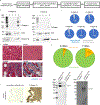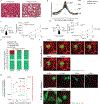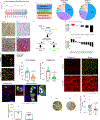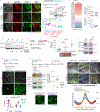A tumor-derived type III collagen-rich ECM niche regulates tumor cell dormancy
- PMID: 35121989
- PMCID: PMC8818089
- DOI: 10.1038/s43018-021-00291-9
A tumor-derived type III collagen-rich ECM niche regulates tumor cell dormancy
Abstract
Cancer cells disseminate and seed in distant organs, where they can remain dormant for many years before forming clinically detectable metastases. Here we studied how disseminated tumor cells sense and remodel the extracellular matrix (ECM) to sustain dormancy. ECM proteomics revealed that dormant cancer cells assemble a type III collagen-enriched ECM niche. Tumor-derived type III collagen is required to sustain tumor dormancy, as its disruption restores tumor cell proliferation through DDR1-mediated STAT1 signaling. Second-harmonic generation two-photon microscopy further revealed that the dormancy-to-reactivation transition is accompanied by changes in type III collagen architecture and abundance. Analysis of clinical samples revealed that type III collagen levels were increased in tumors from patients with lymph node-negative head and neck squamous cell carcinoma compared to patients who were positive for lymph node colonization. Our data support the idea that the manipulation of these mechanisms could serve as a barrier to metastasis through disseminated tumor cell dormancy induction.
© 2021. The Author(s), under exclusive licence to Springer Nature America, Inc.
Conflict of interest statement
Figures












Comment in
-
Pulling the strings of tumor collagen.Nat Cancer. 2022 Jan;3(1):9-10. doi: 10.1038/s43018-021-00323-4. Nat Cancer. 2022. PMID: 35121996 No abstract available.
References
-
- Holmgren L, O’Reilly MS & Folkman J Dormancy of micrometastases: balanced proliferation and apoptosis in the presence of angiogenesis suppression. Nat. Med 1, 149–153 (1995). - PubMed
Publication types
MeSH terms
Substances
Grants and funding
LinkOut - more resources
Full Text Sources
Other Literature Sources
Medical
Molecular Biology Databases
Research Materials
Miscellaneous

